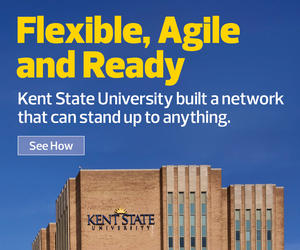Describing what happened next as a “holistic implementation” designed to bolster and add resiliency to the network, Rathje says his team looked to Aruba networking solutions to get the project off the ground.
As the school community deserted Kent State’s campus, “the first thing we realized is that our network traffic patterns would be completely different,” he says. They also recognized that remote learning would call for more streaming, including video. With those potential stress points in mind, and with funding available through the federal CARES Act, Rathje’s team trained its focus on a network switching upgrade and on improving the school’s switching and wireless monitoring, he says.
RELATED: Which CARES Act-funded technologies best support underserved remote learners?
First, to facilitate better switch management — and because Kent State’s IT infrastructure is built on ArubaOS 8 technology — the team added a tool called Aruba NetEdit, which coordinates and automates switch configuration. On the network monitoring front, it turned to Aruba AirWave, a multivendor management platform that streamlines monitoring of wired and wireless infrastructure.
AirWave also provides real-time visibility into access points, switches and controllers, and the devices and applications running on a network. Aruba NetEdit, on the other hand, tackles the challenges associated with network switches. With automated workflows and analytics capabilities, it allows IT teams to easily configure multiple switches at once and make networkwide changes quickly and efficiently.
Just as it’s been for higher education as a whole, the past year was extremely challenging for the Kent State community, Rathje says. Still, when it comes to connectivity, he thinks the university has more than held its own.
LEARN MORE: Read the case study on Kent State University's network upgrades.
“The way we’ve designed and engineered our network,” Rathje says, “we’re going from a two-lane road to a six-lane expressway that can handle any type of vehicle with ease.”
Whether that traffic includes thousands of students accessing digital resources from distant locations or the same number logging in to the university’s systems from onsite classrooms and residence halls, Rathje thinks Kent State’s network is now built to stand up to anything that comes its way. “It gives us exactly what we need today, and it gives us the flexibility to adapt in the future,” he says.













